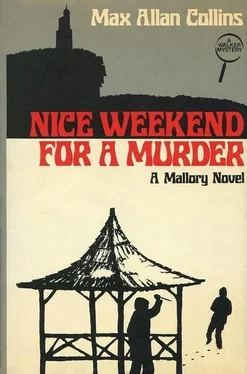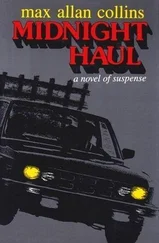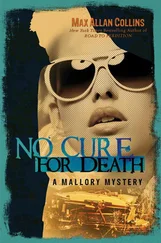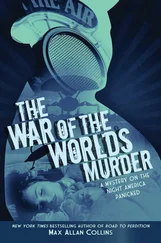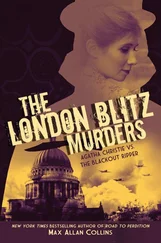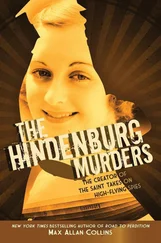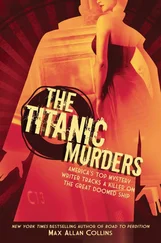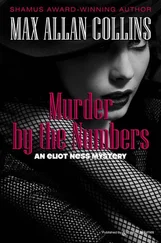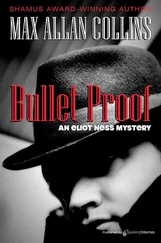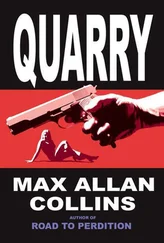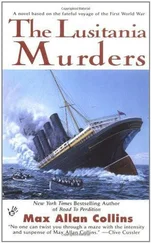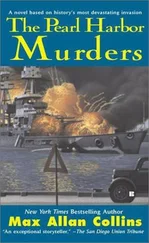And now I was in the Great Out-of-Doors, on a rocky, root-veined hard dirt path upon which icy snow was settling, only it was too late to turn back. We were almost there.
And in five minutes, we were. Our path merged with a crushed-rock road, a one-lane affair used by horses and service vehicles (our map called it a carriage road), which had wound its own way to Sky Top, that plateau where on a clear day you could see forever, or anyway New Jersey and four or five other states. This wasn’t a clear day but, from the outcroppings of boulders along the edge, you could see a panorama of winter gray, broken up by evergreens, that did take the breath away, or maybe it was just the climb.
“Oh, Mal,” Jill said, her gloved hand grasping mine. “Isn’t it breathtaking!”
“Maybe it’s just the climb,” I offered, but I smiled at her.
Sky Top was a clearing about half the size of a football field, and in its midst was a tower of rough-cut stone, a fairly squat two stories or so, with a spire that aspired to another story, capped by a gray-green helmet wearing a flagpole. No flag flew today, and when we tried the tower door, it was locked.
The crushed-rock carriage road extended around the tower, and as we strolled, gloved hand-in-hand, around it to try out another view from Sky Top, we noticed something.
A car.
A car parked on the carriage road, behind the tower. It was fairly well covered with snow, a sporty little dark blue Fiat. I tried the doors, but they were locked. I rubbed the frost from a side window and peered in. On the backseat a stack of magazines sat like a forgotten passenger.
The latest issue of The Mystery Chronicler , forty or fifty copies, probably.
“I think I know whose car this is,” I said.
“What do you mean?” Jill asked; her eyes were wide.
“Let’s have a look around.”
We found him in one of the outcroppings of rocks. Like his car, he was fairly well covered with snow. The front of his jacket was slashed and blood was dried there, or frozen, or something. Dark and crusty, whatever it was. His face was slashed several times, and the wounds were not recent; they had snow in them, and were jagged and crusted with black blood, but the features were recognizable.
It was Kirk S. Rath, all right.
And Jill, not being a stereotypical female, did not scream; neither did I. I’d seen dead bodies before. I’d even seen this dead body before. I bent over him, poked at him a bit: no question he was gone. There seemed to be two deep wounds in his chest; those stab wounds, not the facial slashes, had killed him. Rath’s face seemed oddly passive, for having been slashed; peaceful, youthful, though older than this you don’t get. I checked his pockets. His billfold, containing several hundred dollars in cash, was intact in his back pocket. The envelope in which he’d received his mystery weekend instructions was folded in his pocket; in it was the list of the suspects in his — or Roark K. Sloth’s — murder.
Then I backed away from him. Away from the rocks, away from the drop-off, away from the long, cold fall. For all my bitching, I hadn’t noticed the sound of the storm till now; but now the wind seemed to be fairly screaming. The snow was really coming down, now, and there was indeed ice in it. Crystals glistened on the slashed face of the corpse sprawled on Sky Top’s rocks.
Jill and I stood shivering together, not entirely from the cold, and then started down. The map suggested walking the carriage path on the return, for a “gentler” return trip. But our near-panic and the increasing snow and the steepness of the way had us stumbling, sliding. By the time the carriage road intersected with Sky Top Path at the foot of the mountain, we were walking through a blizzard. We were just about to really panic when suddenly the Mountain House loomed before us.
We stood under the bare beams of the east porch, breathing hard and smoky, shaking the snow off our clothes onto the bare gray wooden slats beneath us. Despite the blizzard out there, the direction of the wind was such that the floor of the open porch was barely dusted with white, when I’d expected it to be drifted. Which it soon would be — the wind was whirling and would get around to it; the lake already was gone, its gray-blue surface buried beneath the white. Faces in the windows along the porch stared out into the ever-whitening world, some awestruck, others indifferent, while below the windows countless rocking chairs made a wooden chorus line. This time of year no one sat out in them, not in this cold, so the chairs were turned on end, rockers up, like a row of curved yellowed tusks in some elephant’s graveyard.
We stamped the snow from our feet on the mats inside the porch doors, but didn’t take off our outer winter clothing, barreling right on into the Lake Lounge, where Curt Clark was giving an informal question-and-answer session during the traditional Mohonk afternoon “tea” — cookies and cups, very genteel. Just like in a British drawing-room mystery.
Only I didn’t remember grotesquely maimed corpses like Kirk Rath’s showing up in such polite mysteries; or, if they did, the author would present an image considerably more tasteful than the police-photo-accurate dead-body picture that was burned in my brain like a concentration camp tattoo.
Curt glanced at me, smiled, squinted, not knowing what to make of our barging in, all bundled up and with winter dandruff on our shoulders. A hundred or so Mystery Weekenders were seated at tables and some again sat Indian-style on the floor as he stood before them fielding their questions, one of which he was currently in the process of answering: “So, while you may find it hard to accept, there are several movie versions of my novels that I have not seen. That I refuse to see. Friends have warned me off them. And I trust my friends.”
Upon the word friends he had glanced at me, squinting again, shaking his head in some unasked question. Perhaps my expression was sufficiently grave to tell him something was up; I glanced at Jill and her expression told nothing — like the Great-Out-of-Doors we’d just left behind us, her face was frozen.
Mary Wright, in a blue Mohonk blazer (its symbol — a tiny gazebo — on one breast pocket) and a white blouse with a blue ascot, approached us, looking confused and a little put out. Curt was, in the meantime, fielding another question. Mary smiled, but it was a strain; you just don’t walk into the Lake Lounge all wet and snowy.
“Is something wrong?” Mary asked, giving us the benefit of the doubt.
“Yes,” I said. “Perhaps we should talk in your office.”
“All right. Should Curt be there? If I read your tone of voice correctly, this is something serious.”
“Yes.”
She took me by the arm, huddled close. “Does it affect our weekend?”
“Oh yes.”
“Let me get Curt, then. He’s almost finished with this...”
Jill looked at her with flat dislike and said, “This can’t wait, honey.”
Mary let go of my arm and smiled at Jill. It was a smile that had nothing to do with humor or goodwill or cheerfulness. It was a smile that had a lot to do with one woman not appreciating another woman calling her “honey.”
“Mohonk moves at its own pace, dear,” she said to Jill. “No crisis is going to ruffle our composure. Understood?”
Jill just looked at her. She didn’t like being called “dear” any more than Mary liked being called “honey.”
Curt was saying, “And I think that about wraps it up. The rest of the afternoon is open for you to begin sorting through the information you gathered at this morning’s interrogations. Just remember the Mystery Writers of America’s slogan — ‘Crime doesn’t pay... enough.’ ”
Читать дальше
